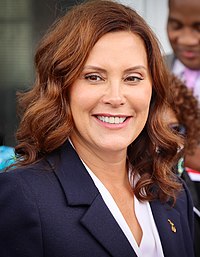The governor of Michigan, is the head of government of the U.S. state of Michigan as well as the commander-in-chief of the state's military forces.[2] The governor has a duty to enforce state laws;[3] the power to either approve or veto appropriation bills passed by the Michigan Legislature;[4] the power to convene the legislature;[5] and the power to grant pardons, except in cases of impeachment.[6] The governor is also empowered to reorganize the executive branch of the state government.[7]
| Governor of Michigan | |
|---|---|
 Seal of the governor | |
 Flag of the governor | |
| Style | Her Excellency[1] |
| Status | |
| Residence | Michigan Governor's Mansion |
| Term length | Four years, renewable once |
| Precursor | Governor of Michigan Territory |
| Inaugural holder | Stevens T. Mason |
| Formation | November 3, 1835 |
| Deputy | Lieutenant Governor of Michigan |
| Salary | $159,300 (2019) |
| Website | www |
In the 17th and 18th century, Michigan was part of French and then British holdings, and administered by their colonial governors. After becoming part of the United States, areas of what is today Michigan were part of the Northwest Territory, Indiana Territory and Illinois Territory, and administered by territorial governors. In 1805, the Michigan Territory was created, and five men served as territorial governors, until Michigan was granted statehood in 1837. Forty-seven individuals have held the position of state governor. The first female governor, Jennifer Granholm, served from 2003 to 2011.
After Michigan gained statehood, governors held the office for a 2-year term, until the 1963 Michigan Constitution changed the term to 4 years. The number of times an individual could hold the office was unlimited until a 1992 constitutional amendment imposed a lifetime term limit of two 4-year governorships. The longest-serving governor in Michigan's history was William Milliken, who was promoted from lieutenant governor after Governor George W. Romney resigned to become Secretary of Housing and Urban Development, then was elected to three further successive terms. The only governors to serve non-consecutive terms were John S. Barry and Frank Fitzgerald.
List of governors
Territory of Michigan
Michigan Territory was organized on June 30, 1805, from the north half of Indiana Territory.[8] It had three governors appointed by the president of the United States, including the longest-serving governor of any territory, Lewis Cass, who served for 18 years.[9]
| No. | Governor | Term in office[a] | Appointed by | |
|---|---|---|---|---|
| 1 |  |
William Hull (1753–1825) [10] |
March 1, 1805[b] – October 29, 1813 (successor appointed)[c] |
Thomas Jefferson |
| James Madison | ||||
| 2 |  |
Lewis Cass (1782–1866) [9] |
October 29, 1813[d] – August 1, 1831 (resigned)[e] |
James Madison |
| James Monroe | ||||
| John Quincy Adams | ||||
| 3 |  |
George Bryan Porter (1791–1834) [24] |
August 6, 1831[f] – July 6, 1834 (died in office) |
Andrew Jackson |
| — |  |
Stevens T. Mason (1811–1843) [27][28] |
July 6, 1834 – September 21, 1835 (successor appointed)[g] |
Territorial secretary acting |
| — |  |
John S. Horner (1802–1883) |
September 21, 1835[33] – July 3, 1836 (resigned)[h] |
Territorial secretary acting |
State of Michigan
Michigan was admitted to the Union on January 26, 1837. The original 1835 Constitution of Michigan provided for the election of a governor and a lieutenant governor every 2 years.[35] The current constitution of 1963 increased this term to four years.[36] There was no term limit on governors until a 1993 constitutional amendment limited governors to two terms.[37]
Should the office of governor become vacant, the lieutenant governor becomes governor, followed in order of succession by the secretary of state and the attorney general.[38] Prior to the current constitution, the duties of the office would devolve upon the lieutenant governor, without that person actually becoming governor.[39] Beginning in 1850, the term begins at noon on January 1 of the year following the election;[40] before, it had no set start date, and terms would last until when their successor was inaugurated, which would be at least the first Monday in January following their election.[41] Prior to the modern 1963 constitution, the governor and lieutenant governor were elected through separate votes, allowing them to be from different political parties. In 1963, this was changed, so that votes are cast jointly for a governor and lieutenant governor of the same political party.[36][42]
See also
Notes
- Hull was court-martialed for surrendering Detroit to the British during the War of 1812, and sentenced to death; that was later commuted.[10] but other sources say he never resigned.[15]
- Cass was appointed on October 29, 1813,[9] during a Senate recess; nominated on January 31, 1814;[16] and confirmed by the Senate on February 11, 1814.[17] He was reconfirmed by the Senate on January 21, 1817;[18] January 24, 1820;[19] December 20, 1822;[20] December 22, 1825;[21] and December 24, 1828.[22]
- Cass resigned, having been appointed United States Secretary of War.[9] He submitted his resignation on July 21, 1831, to take effect on August 1.[23]
- Henry D. Gilpin was appointed on November 5, 1834, during a Senate recess, but he returned his commission on November 8, without declining it, saying he could not leave his present duties for several weeks.[29] He was nominated on December 18, 1834,[30] but was rejected by the Senate on January 20, 1835.[31] Charles Shaler was then appointed on August 29, 1835, but declined the post.[32] His replacement was finally appointed on September 21, 1835. Mason would win the election to be the first state governor on October 5.
- In October 1835, Michigan authorized a state constitution and elected Stevens T. Mason as governor of the new state, although Michigan was not admitted until 1837. Horner was mostly ignored by the people of Michigan, and resigned to be Secretary of Wisconsin Territory in July 1836;[34] the date given is the organization of Wisconsin Territory.
- Woodbridge resigned, having been elected to the United States Senate.[45] His resignation, dated February 23, was accepted by the Senate on February 24.[48]
- Sobel writes that Barry was term-limited under the terms of the 1835 constitution, but no such limit existed.[53]
- Felch resigned, having been elected to the United States Senate.[56]
- McClelland resigned, having been confirmed as United States Secretary of the Interior.[66]
- The 1850 constitution adjusted the election schedules, shortening this term to one year.[66]
- Sources are consistent that Bingham took office on January 3;[72][43] however, the constitutional start date was January 1, and one contemporary source does note that he would have been inaugurated on January 1, and delivered his inaugural address on January 3.[74] However, as this is the only source yet found saying so, this article uses January 3.
- Bingham was instead elected to the United States Senate.[72]
- Represented the Republican Party
- The constitutional start date of the gubernatorial term was January 1; Osborn was not sworn in until January 2, presumably because January 1 was a Sunday.[117]
- The constitutional start date of the gubernatorial term was January 1; Comstock was not sworn in until January 2, presumably because January 1 was a Sunday.[135]
- Comstock lost the Democratic nomination to Arthur J. Lacy.[133]
- January 1 was on a Sunday; Fitzgerald took the oath of office early so he could properly take office on January 1, while his formal inauguration was the next day.[142]
- Represented the Democratic Party
- Romney resigned, having been confirmed as United States Secretary of Housing and Urban Development.[161]
- Under a 1992 amendment to the constitution, no one can be elected more than twice to the office.[171]
- Whitmer's second term began on January 1, 2023,[178] and will expire on January 1, 2027; she will be term-limited.
References
External links
Wikiwand - on
Seamless Wikipedia browsing. On steroids.
















































